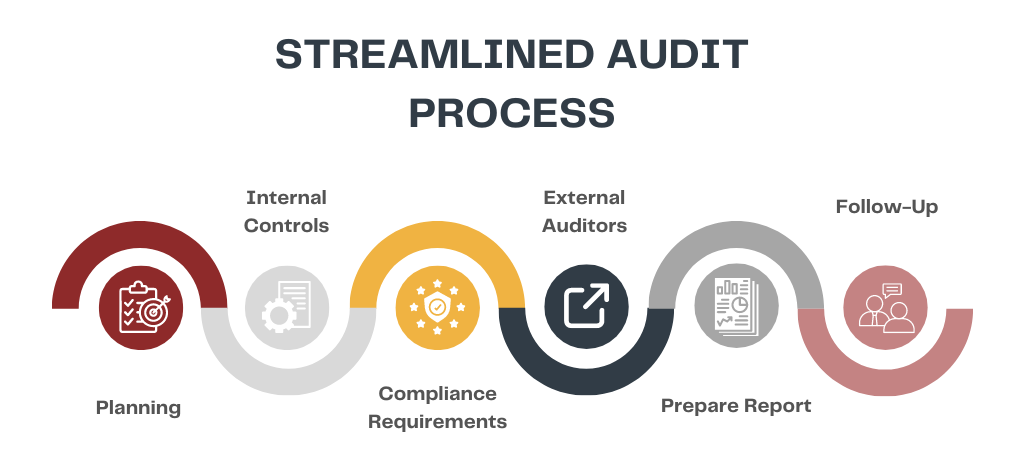
For nonprofit organizations, audits are an essential part of maintaining transparency, accountability, and public trust. However, the audit process can be daunting and time-consuming, often leaving nonprofit leaders feeling overwhelmed. To ensure a smooth and uneventful audit, it is crucial to implement effective preparation strategies that streamline the process and mitigate potential issues. Let’s explore the key steps and best practices that nonprofits can follow to navigate the audit process with confidence and professionalism.

1. Pre-Audit Planning
a. Assemble the Audit Committee
The first step in preparing for an audit is to establish a competent and knowledgeable audit committee. This committee should consist of board members, staff, and external financial experts who possess a deep understanding of the organization’s financial operations. Their role will be to oversee the entire audit process, ensuring compliance with regulations and ethical standards. If assembling an audit committee is not an option for your nonprofit, then the finance committee should assume this responsibility.
b. Identify Audit Objectives and Scope
Work closely with the audit committee and the external auditors to clearly define the audit objectives and scope. This involves identifying specific areas of focus, such as financial statements, internal controls, compliance with regulations, and any other relevant aspects.
c. Organize Necessary Documentation
Compile all the necessary financial documents requested in the PBC list, including financial statements, budgets, ledgers, and transaction records. Ensure that all documents are organized, complete, and readily accessible for the audit team. If this is done throughout the year, rather than only at audit time, it will help expedite the auditing process and prevent unnecessary delays.
2. Strengthen Internal Controls
a. Review Internal Controls
Thoroughly assess and review the organization’s internal controls to identify potential weaknesses or inefficiencies. Address any issues discovered during this review to minimize the risk of errors or fraudulent activities.
b. Implement Checks and Balances
Establish a system of checks and balances to prevent errors and discrepancies in financial transactions. This could involve segregating duties, requiring dual authorization for certain transactions, and implementing strict financial policies.
c. Conduct Internal Reviews
Conduct regular reviews throughout the year to identify and address any discrepancies or irregularities. These internal reviews will help to detect and rectify issues proactively, reducing the likelihood of surprises during the external audit.
3. Compliance with Legal and Regulatory Requirements
a. Familiarize with Reporting Standards
Stay current with the latest accounting and reporting standards, such as Generally Accepted Accounting Principles (GAAP) and Financial Accounting Standards Board (FASB) requirements. Adhering to these standards and requirements helps to ensure accurate and standardized financial reporting.
b. Comply with Tax Laws and Regulations
Ensure that your nonprofit complies with all relevant tax laws and regulations. This includes maintaining accurate records of donations and expenses, as well as timely filing of tax returns and other required documentation.
c. Review Grant Agreements and Funding Sources
For nonprofits that rely on grants and funding, thoroughly review all grant agreements and funding sources to understand the specific reporting requirements and ensure compliance with the terms and conditions.
4. Engage External Auditors
a. Choose the Right Auditing Firm
Selecting the right external auditing firm is crucial. Look for auditors with experience in working with nonprofit organizations. Seek recommendations and conduct interviews to find the best fit for your organization’s needs.
b. Establish a Strong Auditor-Client Relationship
Once an auditing firm is chosen, establish open and clear lines of communication with the audit team. Discuss expectations, timelines, and any specific concerns related to the audit process. A strong auditor-client relationship fosters a collaborative environment and facilitates the smooth flow of information throughout the year.
c. Provide Necessary Support and Information
During the audit, promptly provide the auditors with all requested documentation and support to ensure efficiency. Be transparent and forthcoming with any challenges or issues that may impact the audit findings.
5. Prepare for the Audit Report
a. Internal Review of Preliminary Findings
Conduct an internal review of the preliminary audit findings with the audit committee. Address any discrepancies or areas that need further clarification before the final audit report is issued.
b. Develop Corrective Action Plans
If the audit identifies areas for improvement or highlights weaknesses in internal controls, develop detailed corrective action plans to address these issues. Assign responsibilities and set deadlines for implementation
6. Post-Audit Follow-Up
a. Implement Auditor Recommendations
Act on the recommendations provided by the auditors to improve your nonprofit’s financial practices and internal controls. This demonstrates a commitment to accountability and continuous improvement.
b. Communicate Audit Outcomes
Share the audit outcomes with stakeholders, including the board, donors, and staff members. Transparently communicate the results and the steps taken to address any identified issues.
Preparing for a nonprofit audit can be a complex task, but with a strategic approach and attention to detail, it can be a manageable process. By assembling a competent audit committee, strengthening internal controls, complying with legal requirements, engaging the right external auditors, and actively participating in the audit process, nonprofits can ensure a smooth and uneventful audit. Embracing transparency and accountability throughout the process will not only lead to a successful audit but also reinforce public trust and confidence in the organization’s mission and operations. Remember, a well-prepared audit is not just a regulatory obligation; it is an opportunity to showcase the integrity and effectiveness of your nonprofit to the world.
Share This Post:

Chazin
With over 20 years working exclusively with nonprofits, we pride ourselves in having a unique understanding of nonprofit accounting needs. We believe that nonprofits deserve personalized, quality service and should not settle for a one-size-fits-all approach. We collaborate with you to provide a fully virtual and customized solution that is not only cost-effective but also strengthens your accounting function. We offer a team of industry experts at your disposal to provide advice, leading technology, and to supplement existing staff to improve efficiency and compliance.